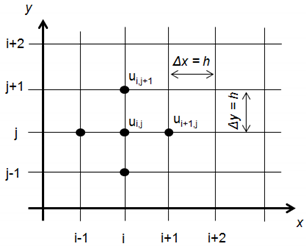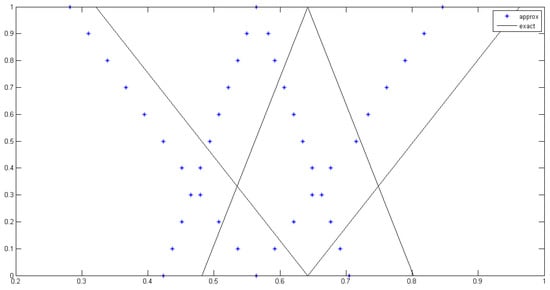Abstract
In this paper, we investigate an intuitionistic fuzzy Poisson equation with uncertain parameters, considering the parameters as intuitionistic fuzzy numbers. We apply a finite difference method to solve the ‘Intuitionistic fuzzy Poisson equation’. The continuity of the membership and non-membership functions (which imply the continuity of the hesitancy function) is used to obtain qualitative properties on regular -cut and -cut of the intuitionistic fuzzy solution. The fuzzification of the deterministic -cut and -cut solutions obtained lead to the intuitionistic fuzzy solution. Finally, an example is presented to illustrate the proposed methodology, as well as to show a graphical representation of its corresponding intuitionistic fuzzy solution.
1. Introduction
One of the fruitful ways of modelling uncertainty and imprecision in particular quantities for certain real-life problems, is Intuitionistic Fuzzy Partial Differential Equations (IFPDEs). IFPDEs have essential applications in diverse fields, such as physics, biology, chemistry, and engineering. We propose a method for the approximate solution of IFPDE using a Finite Difference Method. In [1], J. Buckley and T. Feuring introduced a method for the solution of the fuzzy partial differential equation. In [2], T. Allahvironloo used a numerical method to solve the Fuzzy Partial differential equation that was based on the Seikala derivative. C. Samuel and V. Stefen used a numerical method to solve elliptic FPDE using a polynomial Galerkin approximation. In [3], Man et al. applied the finite difference method to solve an intuitionistic fuzzy heat equation. A. Kermani et al. Numerical methods for fuzzy linear partial differential equations applied by Kermani et al. [4]. An intuitionistic fuzzy set introduced by K.T. Atanassov [5,6]. Intuitionistic fuzzy number and its arithmetic operations discussed by [7,8]. An intuitionistic fuzzy set is an extension of the fuzzy set defined in a domain of discourse. We may obtain better results using IFPDEs rather than FPDEs.
This paper presents a new approach to finding the numerical solution of the intuitionistic fuzzy elliptic equation. We solve the Poisson equation using the finite difference method with intuitionistic fuzzy parameters.
2. Materials and Methods
In the following we consider the Poisson equation
Let us consider and to be a fuzzy function of the independent crisp variables x and y. We define the domain
A()-cuts of and its parametric form will be
We suppose that and have continuous partial derivatives with respect to x and y, therefore and are continuous for all , for all , for all .
We subdivide the intervals , into N equal subintervals of length then the points and .

Denote the value of at the representative mesh point by
and also denote the parametric form of intuitionistic fuzzy number , involving the parameters and , as
Then, we have
Following [2], using Taylor’s theorem and definition of standard difference formula we obtain
with a leading error of . Similarly, using the notation of forward difference approximation for at P, we have
with a leading error of .
This can be written as
3. Results
Consider the fuzzy Poisson’s equation. This example can be found in [2]
where
and
with the boundary conditions
The exact solutions for
are, respectively,
4. Discussion
We have used Equations (24)–(27) to approximate the exact solutions with and . Figure 1 shows the approximate and exact solution at the point for each .

Figure 1.
The intuitionistic fuzzy solution of Poisson equation.
5. Conclusions
The intuitionistic fuzzy partial differential equation can be applied for modelling in physics, engineering, and mechanical system. In this paper, we have developed a finite difference method to solve the intuitionistic fuzzy Poisson equation. Future work may focus on intuitionistic fuzzy partial differential equations to more realistic applications from practice.
Author Contributions
All authors contributed equally to this work. All authors have read and agreed to the published version of the manuscript.
Funding
This research received no external funding.
Institutional Review Board Statement
Not applicable.
Informed Consent Statement
Not applicable.
Data Availability Statement
Enquiries about data availability should be directed to the authors.
Conflicts of Interest
The authors declare no conflict of interest.
References
- Buckly, J.J.; Feuring, T. Fuzzy differential equations. Fuzzy Sets Syst. 2000, 100, 43–54. [Google Scholar] [CrossRef]
- Allahviranloo, T. Difference methods for fuzzy partial differential equations. Comput. Methods Appl. Math. 2002, 2, 233–242. [Google Scholar] [CrossRef]
- Man, S.; Saw, B.C.; Hazra, S.B. An explicit method for solving intuitionistic fuzzy heat equation. Adv. Fuzzy Math. (AFM) 2021, 16, 27–39. [Google Scholar]
- Kermani, A.; Saburi, F. Numerical methods for fuzzy linear partial differential equations. Appl. Math. Comput. 2007, 27, 1299–1309. [Google Scholar]
- Atanassov, K.T. Intuitionistic fuzzy sets. Fuzzy Sets Syst. 1986, 20, 87–96. [Google Scholar] [CrossRef]
- Atanassov, K.T. Ideas for Intuitionistic Fuzzy Sets, Equations, Inequations and Optimization. Notes Intuitionistic Fuzzy Sets 1995, 1, 17–24. [Google Scholar]
- Mahapatra, G.S.; Roy, T.K. Intuitionistic fuzzy number and its arithmetic operation with appilication on system failure. J. Uncertain Syst. 2013, 7, 92–107. [Google Scholar]
- Seikh, M.R.; Nayak, P.K.; Pal, M. Notes on triangular intuitionistic fuzzy numbers. Int. J. Math. Oper. Res. 2013, 5, 446–465. [Google Scholar] [CrossRef]
Disclaimer/Publisher’s Note: The statements, opinions and data contained in all publications are solely those of the individual author(s) and contributor(s) and not of MDPI and/or the editor(s). MDPI and/or the editor(s) disclaim responsibility for any injury to people or property resulting from any ideas, methods, instructions or products referred to in the content. |
© 2023 by the authors. Licensee MDPI, Basel, Switzerland. This article is an open access article distributed under the terms and conditions of the Creative Commons Attribution (CC BY) license (https://creativecommons.org/licenses/by/4.0/).